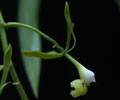|
|
|
|
|
| |
Flasks of
Epidendrum paniculatum 'MC1707' × self |
|
| |
|
|
| |
| Number: |
TN2880 |
| Name: |
Epidendrum paniculatum 'MC1707' × self
|
| |
Very LOW yield.
|
| Type: |
self (What's that?) |
|
Seed Donor: |
Carol J. Watson
(Email: CJWatson@cox.net)
|
|
Click to Enlarge

Offspring 'MC2980' Flower |
Click to Enlarge

Offspring 'MC2980' Flower, Side View |
Click to Enlarge

Offspring 'MC2980' Inflorescence |
| Offspring photos are siblings of the plants you would receive. |
|
|
|
| |
Culture Notes from Donor: Parent plant: Temperature range W (70-90°F)
Comments: Epidendrum paniculatum is found throughout tropical America growing both terrestrially and epiphytically at altitudes below 2000m. It has panicles of charming apple green flowers with bright snow white lips and can bloom more than once a year. The flowers open over a long period thereby extending the length of the blooming period.
Parent plant: This particular plant is smaller than the usual 1 meter to which this reedstem usually grows, instead being about 35 cm in height. It is spreading-pendent and does best mounted or in a basket. Does well even under neglect.
For additional origin/habitat information supplied courtesy of
Charles and Margaret Baker, see further below, near the bottom of this page.
|
Temperatures we attempt to use in the lab & greenhouse:
| For Species: |
|
Spring, Summer, Autumn: days average 73°F, nights 55°F; best fit is Cool-Intermediate 75-58°F
(Source:
Baker's Web OSC) |
| For Species: |
|
Winter: days average 70°F, nights 52°F; best fit is Cool 70-52°F
(Source:
Baker's Web OSC) |
|
About the name...
| Etymology of |
Epidendrum |
|
From Greek "epi" upon; "dendron" tree.
(Source:
Pridgeon 1992) |
| Etymology of |
paniculatum |
|
From Latin "paniculus" tuft, the diminutive of "panus" an ear of millet. More directly refers to the botanical term "panicle", a compound inflorescence with the younger flowers at the apex or center; a compound raceme or corymb.
(Sources:
Brown 1956, Harrington & Durrell, Troy Meyers) |
| Pronunciation of |
Epidendrum |
|
eh-pee-DEN-drum
(Source:
Pridgeon 1992) |
| Pronunciation of |
paniculatum |
|
pan-ik-yoo-LAH-tum
(Source:
Hawkes 1978) |
|
If you would like to direct someone to this web page, please copy and paste this URL into your email:
http://troymeyers.com/d?012880
| Flask Information |
| Availability: |
We had yield problems with this item, so we didn't continue flasking it. |
| You should: |
Consider placing a "Notify Retries" Request, and if an identical pollination (the same parents) is done again, we'll let you know. |
| Plantlet Sizes: |
From many flasks 1 - 3 mm plants (based on flask surveys done 09/27/2002 )
From one most recently surveyed flask 1 - 3 mm (09/27/2002)
|
|
You might also want to:
|
View the seed assay for this item.
View items of the same species.
View items of the same genus.
|
|
|
| |
The origin/habitat information below is supplied courtesy of Charles and Margaret Baker
The following information is based on the name of the plant provided by the donor, and assumes that the name is correct. If the plant has been misidentified, then the following information may not be correct.
This text is copyrighted by the Bakers and may not be reproduced without permission.
ORIGIN/HABITAT: Originally found in Peru, Epidendrum paniculatum and its
synonyms are now known to occur in Bolivia, Ecuador, Brazil, Colombia, and
Venezuela. These plants are extremely variable in appearance and are found
over a wide range of habitat types and elevations, hence the extremely
large number of synonyms. In Peru, plants have been collected from
locations throughout the country on both the eastern and western slopes of
the Andes, but mostly on the eastern slopes, at elevations of 350-8350 ft.
(100-2550 m). Most plants seem to be found at 3950-6550 ft. (1200-2000 m),
however. Throughout Peru, collections have been reported in the
Departments of Ayacucho, Cajamarca, Cuzco near Machu-Picchu as well as
many other locations, Huánco near Tingo María and several other locations,
Junín in the Chanchamayo Valley as well as other locations, Loreto near
Moyobamba and Iquitos as well as other locations, and San Martín. In
Ecuador, plants have been found as both epiphytes and terrestrials on
steep slopes in wet mountain cloudforests in Pichincha Province at
(1400-1800 m). This orchid is also widespread in Venezuela, being found in
the states of Bolívar, Falcón, Mérida, Miranda, Monagas, Táchira,
Trujillo. The Federal Territory of Amazonas, and the Federal District near
Caracas. Plants are reported from elevations of 1650-8200 ft. (500-2500
m), but most collections seem to be from 5250-7200 ft. (1600-2200 m). In
Brazil, plants are reported from the hot, moist lowlands to high
elevations in the mountains in the states of Pará, Amazonas, Espírito
Santo, Matto Grosso, Goias, Minas Gerais, Rio de Janeiro, São Paulo,
Paraná, Santa Catarina, Rio Grande do Sul, and the Federal District.
More about this information and the Bakers...
|
|
|
| |
|
|
|